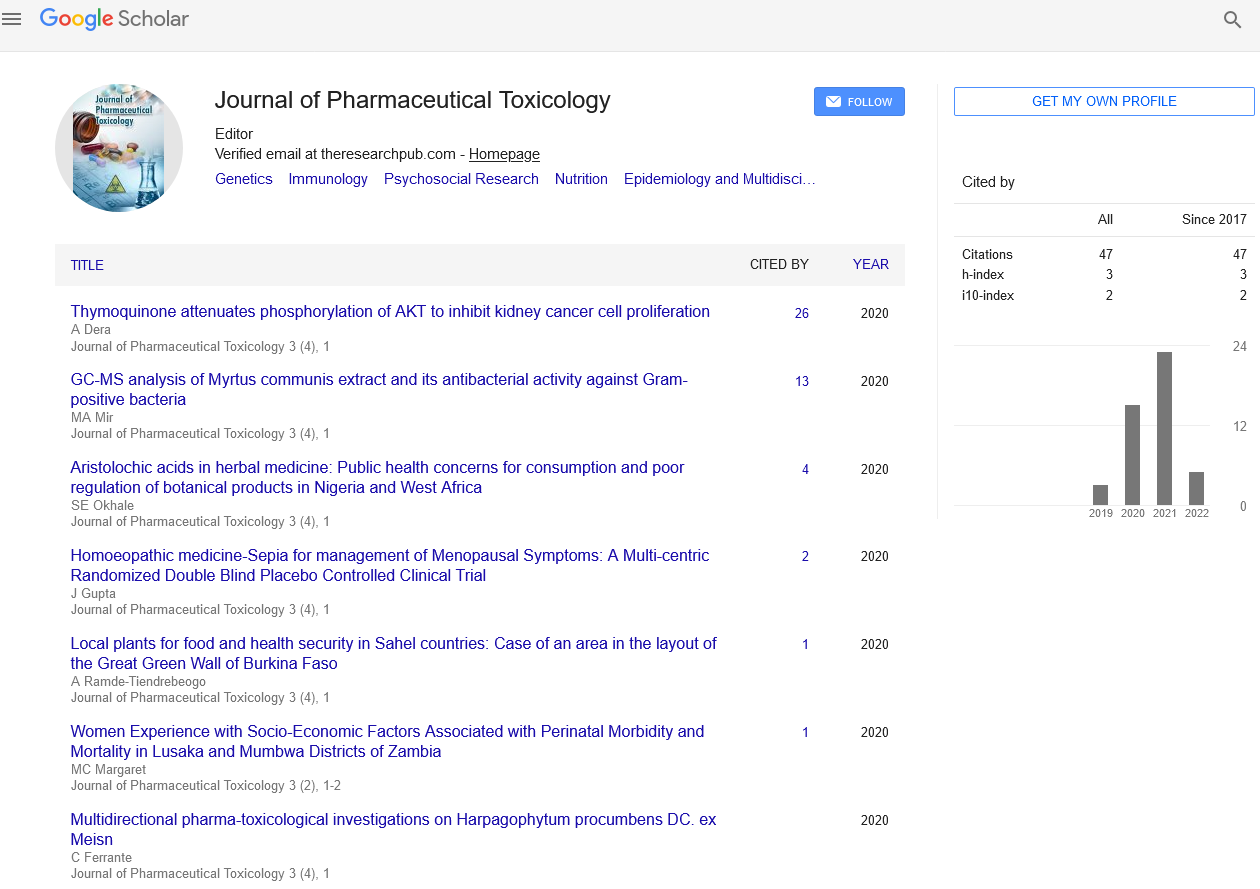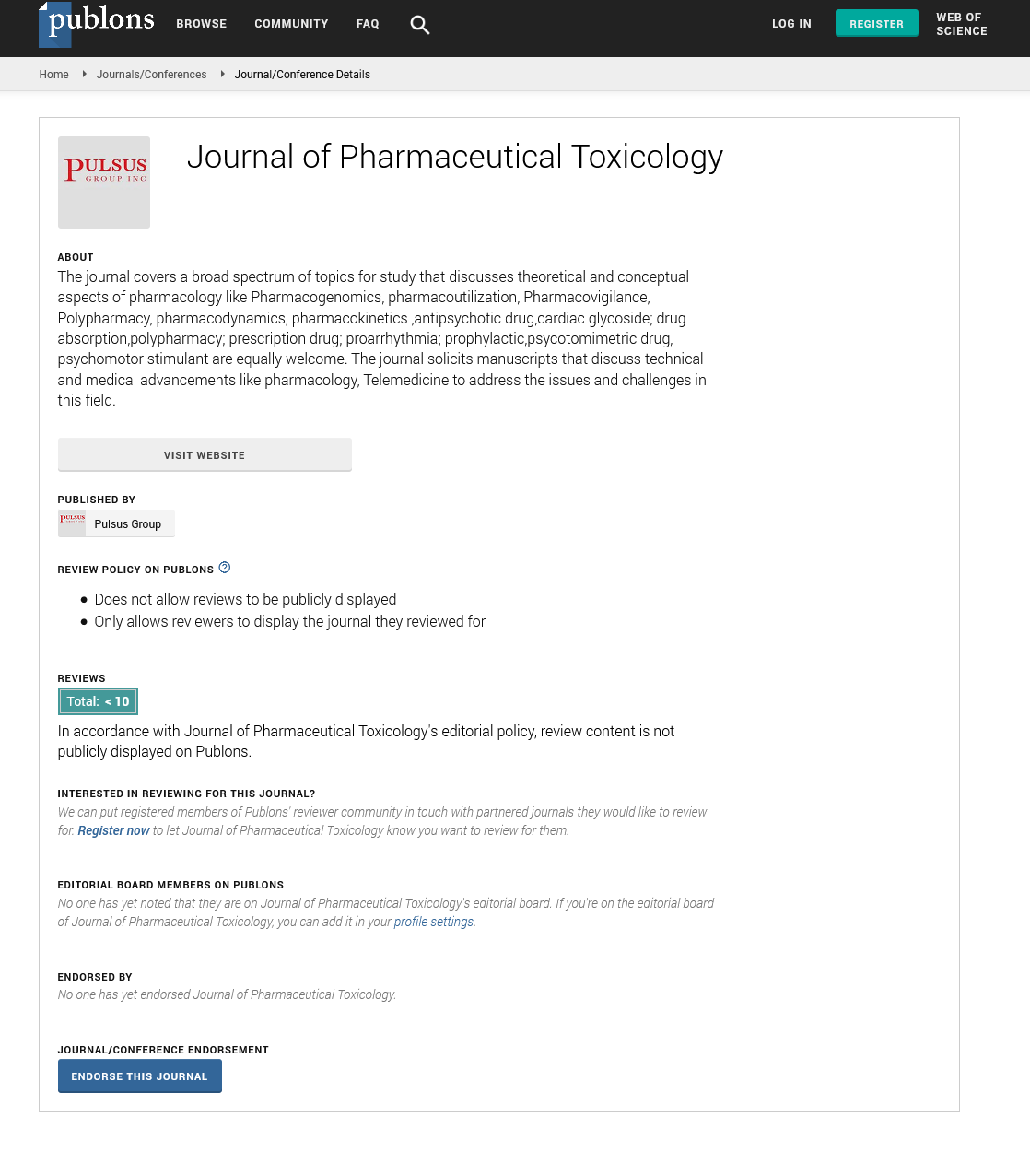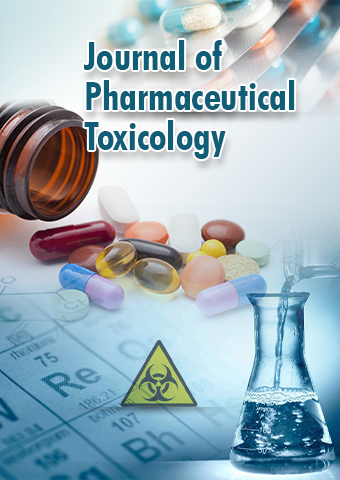Research Article - Journal of Pharmaceutical Toxicology (2023) Volume 6, Issue 4
Pharmaceutical Company Markets and Distributes the Drug to Healthcare Providers
Robert Mark*
Department of Cardiovascular Medicine, Mayo Clinic, Rochester, MN, USA
Department of Cardiovascular Medicine, Mayo Clinic, Rochester, MN, USA
E-mail: rob.@91gmail.com
Received: 01-August-2023, Manuscript No. oajpt-23-108579; Editor assigned: 3- August -2023, PreQC No. oajpt-23-108579 (PQ); Reviewed: 17- August -2023, QC No. oajpt-23-108579; Revised: 22- August -2023, Manuscript No. oajpt-23-108579 (R); Published: 28- August -2023; DOI: 10.37532/ jpt.2023.6(4).122-125
Abstract
Pharmaceuticals refer to drugs or medications that are designed and manufactured for the purpose of preventing, diagnosing, treating, or managing diseases, medical conditions, and health disorders in humans and animals. The pharmaceutical industry plays a critical role in healthcare, as it develops and produces a wide range of therapeutic agents to improve health outcomes and enhance the quality of life for individuals. This initial stage involves identifying potential drug candidates. Researchers explore various sources, including plants, animals, microbes, and synthetic compounds, to find molecules that may have therapeutic effects. Once promising drug candidates are identified, they undergo extensive laboratory testing and preclinical studies using cells, tissues, and animal models to evaluate their safety, efficacy, and potential side effects
Introduction
If a drug candidate shows promise in preclinical studies, it moves on to clinical trials in humans. These trials are conducted in different phases, starting with Phase I (small groups of healthy volunteers) and progressing to Phase II (larger groups of patients) and Phase III (large-scale studies to assess safety and effectiveness). After successful completion of clinical trials and the demonstration of safety and efficacy, the pharmaceutical company submits the drug for approval to the regulatory authorities in the respective countries. Once the drug is approved, it enters the manufacturing phase, where it is produced in large quantities under strict quality control to ensure consistency and safety. After manufacturing, the Pharmaceutical Company Markets and Distributes the Drug to Healthcare Providers, pharmacies, hospitals, and other medical facilities [1,2].
Even after a drug is approved and on the market, ongoing monitoring occurs to identify any rare or long-term side effects and to ensure its continued safety and effectiveness have made significant contributions to modern medicine, helping to manage and cure numerous diseases and conditions, improve life expectancy, and enhance the overall well-being of individuals worldwide. However, the development of pharmaceuticals is a complex and costly process, often taking many years and substantial financial investment. The pharmaceutical industry faces various challenges, including strict regulatory requirements, patent expirations, and concerns about access to essential medications. Pharmaceuticals refer to drugs or medications used for the prevention, diagnosis, treatment, or relief of medical conditions in humans or animals. These substances are specifically designed and developed by pharmaceutical companies through extensive research and rigorous testing processes to ensure their safety, efficacy, and quality [3,4].
Material & Methods
Discovery and research: This stage involves identifying potential drug targets, often specific molecules or biological processes associated with a disease or condition. Researchers conduct extensive studies to understand the underlying mechanisms and pathways involved.
Preclinical Testing: After identifying a potential drug candidate, it undergoes preclinical testing in laboratory settings using cells and animal models to assess its safety and effectiveness. Researchers study the drug’s pharmacokinetics (absorption, distribution, metabolism, and excretion) and pharmacodynamics (effects on the body) during this phase.
Clinical trials: If a drug candidate shows promising results in preclinical testing, it progresses to clinical trials. These trials involve human volunteers and are conducted in multiple phases (Phase I to Phase III), each with increasing numbers of participants. Phase I trials assess the drug’s safety in a small group, while Phases II and III assess its efficacy and safety in larger patient populations.
Regulatory approval: Once the clinical trials demonstrate that the drug is safe and effective, pharmaceutical companies submit a New Drug Application (NDA) or Marketing Authorization Application (MAA) to regulatory agencies, such as the Food and Drug Administration (FDA) in the United States or the European Medicines Agency (EMA) in Europe. These agencies thoroughly review the data to determine whether the drug can be approved for marketing.
Post-marketing surveillance: After the drug is approved and available for use, ongoing monitoring continues to assess any rare or longterm side effects that may not have been apparent during the clinical trials. This phase ensures that the drug’s safety profile remains acceptable.
Results
Pharmaceuticals encompass a wide range of products, including prescription medications, over-the-counter drugs, vaccines, biologics (therapies derived from living organisms), and various medical devices. They play a crucial role in modern medicine, helping to treat and manage a wide array of medical conditions and improving the quality of life for millions of people worldwide. However, it is essential to use pharmaceuticals responsibly, following healthcare professionals’ advice and guidelines to avoid misuse or adverse effects. Pharmaceuticals, also known as drugs or medications, are substances used to diagnose, treat, prevent, or alleviate diseases, medical conditions, or symptoms in humans and animals. These compounds are carefully developed and manufactured by pharmaceutical companies following strict guidelines and regulations set by health authorities.
Research and development (R&D): Pharmaceutical companies invest significant time and resources in researching potential new drugs. This phase often begins with identifying a disease or medical condition for which there is a need for a treatment. Scientists then explore various chemical and biological compounds that may have the desired therapeutic effect.
Preclinical testing: In this stage, the potential drug candidates are tested in the laboratory and on animals to determine their safety, effectiveness, and possible side effects. These studies help researchers narrow down the list of compounds for further evaluation.
Manufacturing and distribution: Once approved, the pharmaceutical company manufactures the drug in controlled conditions to ensure consistency and quality. The medication is then distributed to healthcare providers and pharmacies for patient use.
After a drug is available on the market, ongoing monitoring and reporting of adverse effects occur to identify any unexpected side effects or long-term consequences. Pharmaceuticals can be administered in various forms, including tablets, capsules, liquids, creams, injections, and inhalants. Some drugs require a prescription from a licensed healthcare professional, while others are available over-the-counter (OTC) without a prescription. Pharmaceuticals, often referred to as drugs or medications, are substances designed to diagnose, treat, cure, or prevent diseases and medical conditions in humans and animals. These substances are typically developed through rigorous research, testing, and approval processes to ensure their safety and effectiveness. The pharmaceutical industry plays a critical role in modern healthcare, and pharmaceutical products come in various forms, such as pills, tablets, capsules, liquids, creams, ointments, injectable, and more. They can be used for a wide range of purposes, including alleviating symptoms, managing chronic conditions, eradicating infections, and improving overall health.
Discussion
Pharmaceutical companies invest significant resources in research and development to discover new drugs and improve existing ones. This process involves identifying potential drug candidates, conducting pre-clinical studies in laboratories and animal models, and then progressing to clinical trials in humans. Before a pharmaceutical product can be approved for use, it must undergo rigorous clinical trials. These trials are conducted in several phases and involve testing the drug on human volunteers to assess its safety, efficacy, and potential side effects. Regulatory authorities closely monitor and evaluate the data from these trials before granting approval. Pharmaceutical products can be classified into two main categories: prescription drugs and over-the-counter (OTC) drugs. Prescription drugs require a doctor’s prescription, while OTC drugs can be purchased directly by consumers without a prescription for self-treatment of common ailments. Once a pharmaceutical patent expires, other manufacturers can produce generic versions of the drug. Generic drugs are equivalent to the original brand-name drug in terms of active ingredients, dosage, safety, efficacy, and intended use, but they are usually available at a lower cost [5,6].
Pharmaceuticals exert their effects through various mechanisms of action. They may interact with specific receptors in the body, inhibit or enhance certain biochemical processes, or target pathogens to combat infections. While pharmaceuticals provide significant benefits, they can also have side effects and adverse reactions. The severity and likelihood of these effects vary depending on the drug and the individual’s response to it. Pharmaceuticals have revolutionized modern medicine, contributing to increased life expectancy, improved quality of life, and better management of various health conditions. However, their development, usage, and regulation require a delicate balance between ensuring patient safety and providing access to effective treatments. As such, ongoing research, monitoring, and innovation continue to be essential components of the pharmaceutical industry.
Pharmaceuticals, also known as drugs or medications, refer to chemical substances or compounds used for diagnosing, treating, preventing, or alleviating diseases, medical conditions, or health issues in humans and animals. These substances play a crucial role in modern healthcare and have significantly improved the quality and length of human life. The pharmaceutical industry is involved in the research, development, production, and distribution of drugs. Pharmaceutical companies invest substantial resources in scientific research to discover and create new medications, as well as to improve existing ones. Pharmaceuticals, also known as drugs or medications, are substances or compounds that are used to diagnose, treat, cure, or prevent diseases and medical conditions in humans and animals. They play a crucial role in modern healthcare by helping to alleviate symptoms, manage chronic conditions, and improve overall quality of life. Pharmaceuticals are developed through a rigorous process of research, testing, and approval to ensure they are safe and effective for use [7-9].
Pharmaceuticals, also known as drugs or medications, are substances used to diagnose, treat, cure, prevent, or mitigate diseases and medical conditions in humans and animals. These substances play a crucial role in modern healthcare and have significantly improved the quality of life and life expectancy for many people. The pharmaceutical industry is responsible for the research, development, production, and distribution of these drugs. The process of creating a new pharmaceutical product typically involves several stages. This is the initial phase where researchers identify and validate potential drug candidates. They may start with a target molecule, such as a protein or enzyme involved in a disease process, and search for compounds that interact with it.
Preclinical testing: After potential drug candidates are identified, they undergo rigorous testing in laboratory and animal models to assess their safety, efficacy, and potential side effects. This stage is essential for identifying promising candidates before they proceed to human trials [10].
Conclusion
If a drug candidate passes preclinical testing, it enters clinical trials involving human volunteers. These trials are conducted in multiple phases to evaluate safety, dosage, effectiveness, and potential interactions with other drugs. Clinical trials are highly regulated and require approval from regulatory authorities before they can proceed. Regulatory Approval: After successful clinical trials, pharmaceutical companies submit their data to regulatory agencies, such as the Food and Drug Administration (FDA) in the United States or the European Medicines Agency (EMA) in Europe, to seek approval for marketing and distribution. Production and Distribution: Once a pharmaceutical product receives regulatory approval, it can be manufactured on a larger scale. The production process must adhere to strict quality control standards to ensure consistency and safety. The drugs are then distributed to pharmacies, hospitals, and other healthcare facilities for patient use.
References
- Saraswat A. Topical corticosteroid use in children: Adverse effects and how to minimize them.Indian J. Dermatol. Venereol. Leprol.76, 225–228 (2010).
- Beggs S. Paediatric analgesia.Aust Prescr.31, 63–65 (2008).
- Rossi M, Giorgi G. Domperidone and long QT syndrome.Curr Drug Saf., 5, 257–262 (2010).
- Kosek M, Bern C, Guerrant RL. The global burden of diarrhoeal disease, as estimated from studies published between 1992 and 2000.Bull World Health Organ.81, 197–204(2003).
- Alam N, Najam R. Effect of repeated oral therapeutic doses of methylphenidate on food intake and growth rate in rats.Pak J Pharm Sci.28 9–13(2015).
- Ryan C, Ross S, Davey P et al. Prevalence and causes of prescribing errors: The PRescribing Outcomes for Trainee Doctors Engaged in Clinical Training (PROTECT) study.PLoS ONE.9, 69-143 (2006).
- Patrick DM, Marra F, Hutchinson J et al. Per capita antibiotic consumption: How does a North American jurisdiction compare with Europe? Clin Infect Dis. 39, 11-17 (2004).
- Li WC. Occurrence, sources, and fate of pharmaceuticals in aquatic environment and soil. Environ Pollute. 187, 193-201 (2014).
- Heberer T. Occurrence, fate, and removal of pharmaceutical residues in the aquatic environment:A review of recent research data. Toxicol Lett. 131, 5-17 (2002).
- Banci L, Ciofi-Baffoni S, Tien M Lignin et al. Peroxidase-catalyzed oxidation of phenolic lignin oligomers. Biochemistry. 38, 3205-3210 (1999).
Indexed at, Google Scholar, Crossref
Indexed at, Google Scholar, Crossref
Indexed at, Google Scholar, Crossref
Indexed at, Google Scholar, Crossref
Indexed at, Google Scholar, Crossref


